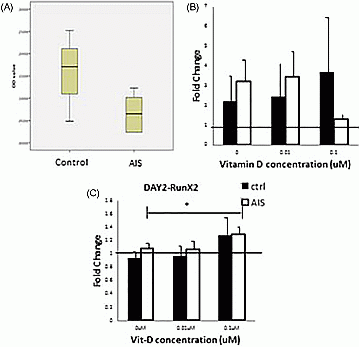ICCBH2015 Poster Presentations (1) (201 abstracts)
Vibration treatment can enhance the bioactive response of osteoblasts to vitamin D in adolescent idiopathic scoliosis patients
Jiajun Zhang 1, , WayneY W Lee 1, , Benlong Shi 2, , Elisa M S Tam 1, , Huanxiong Chen 1, , Simon K M Lee 3 , Bobby K W Ng 1, , Jack C Y Cheng 1, & Tsz Ping Lam 1,
1Department of Orthopaedics and Traumatology, The Chinese University of Hong Kong, Hong Kong, Hong Kong; 2Joint Scoliosis Research Center of the Chinese University of Hong Kong and Nanjing University, Hong Kong, Hong Kong; 3Lee Hysan Clinical Research Laboratories, The Chinese University of Hong Kong, Hong Kong, Hong Kong; 4Spine Surgery, The Affiliated Drum Tower Hospital of Nanjing University Medical School, NanJing, China.
Objectives: Adolescent idiopathic scoliosis (AIS) is a complex three-dimensional spinal deformity associated with low bone mass. Our previous clinical trial demonstrated the anabolic bone effect of vibration treatment (VT) at the femoral neck in AIS subjects. The therapeutic effect was more pronounced in those with optimal serum 25(OH) Vit-D level (>40 nmol/l). To investigate possible factor interaction between Vit-D and VT on their anabolic bone effects, this in-vitro study was performed to evaluate whether VT could positively modulate the response of AIS primary osteoblasts to Vit-D.
Method: Osteoblasts were isolated from iliac crest biopsy harvested from AIS subjects (n=7) and non-AIS controls (n=3). Osteoblasts were treated with 0.10 nM and 100 nM of 1.25(OH)2Vit-D with or without VT (0.3 g, 35 Hz for 20 min pr day). Cell metabolic activity was determined by Alarma blue. Gene expression of osteogenic markers were determined by real time PCR. Mineralization ability was determined by ALP and Alizarin red staining. Semi-quantitation was done for statistical analysis.
Results: When compared with controls, AIS osteoblasts had lower intrinsic calcium deposition and ALP activity. Enhancement effect of VT on response of osteoblasts to Vit-D as evidenced from increased degree of mineralization, Runx2, ALP and SPP1 mRNA expression in osteoblasts was more explicitly seen in AIS than in controls.
Conclusion: The greater response of AIS osteoblasts to concurrent treatment with Vit-D and VT might be part of the mechanism underlying the modulating effect of Vit-D level on anabolic bone effects of VT seen in the clinical trial. Further studies looking into the underlying mechanism could shed lights on the etiopathogenesis and other biochemical anomalies that characterize AIS.
This study was supported by CUHK Direct Grant (2012.1.034).
Disclosure: The authors declared no competing interests.

Figure (A) AIS (n=7) formed less calcium nodules than control (n=3) at Day 7 without treatment; (B) OSteoblast of AIS (n=7) showed more mineralization than control with vibration and vitamin D at concentration of 0 μM and 0.01 μM; (c) mRNA expression of RunX2 in AIS was significantly upregulated with vibration and vitamin D at concentration of 0.1 μM (p<0.05). Fold change was calculated by vibration relative to non-vibration.




